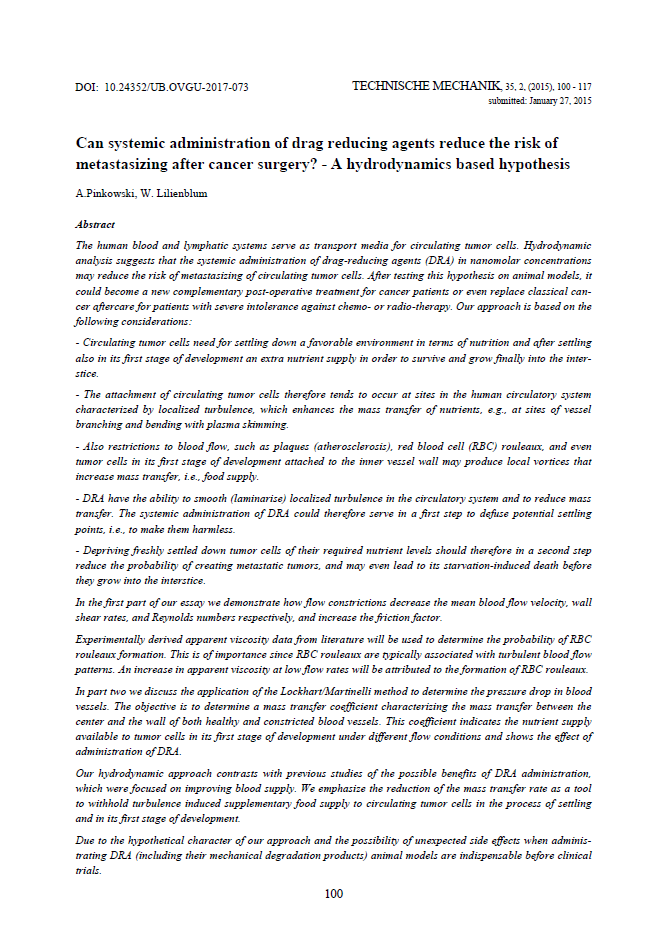Can systemic administration of drag reducing agents reduce the risk of metastasizing after cancer surgery?
A hydrodynamics based hypothesis
DOI:
https://doi.org/10.24352/UB.OVGU-2017-073Abstract
The human blood and lymphatic systems serve as transport media for circulating tumor cells. Hydrodynamic analysis suggests that the systemic administration of drag-reducing agents (DRA) in nanomolar concentrations may reduce the risk of metastasizing of circulating tumor cells. After testing this hypothesis on animal models, it could become a new complementary post-operative treatment for cancer patients or even replace classical cancer aftercare for patients with severe intolerance against chemo- or radio-therapy. Our approach is based on the following considerations:
- Circulating tumor cells need for settling down a favorable environment in terms of nutrition and after settling also in its first stage of development an extra nutrient supply in order to survive and grow finally into the interstice.
- The attachment of circulating tumor cells therefore tends to occur at sites in the human circulatory system characterized by localized turbulence, which enhances the mass transfer of nutrients, e.g., at sites of vessel branching and bending with plasma skimming.
- Also restrictions to blood flow, such as plaques (atherosclerosis), red blood cell (RBC) rouleaux, and even tumor cells in its first stage of development attached to the inner vessel wall may produce local vortices that increase mass transfer, i.e., food supply.
- DRA have the ability to smooth (laminarise) localized turbulence in the circulatory system and to reduce mass transfer. The systemic administration of DRA could therefore serve in a first step to defuse potential settling points, i.e., to make them harmless.
- Depriving freshly settled down tumor cells of their required nutrient levels should therefore in a second step reduce the probability of creating metastatic tumors, and may even lead to its starvation-induced death before they grow into the interstice.
In the first part of our essay we demonstrate how flow constrictions decrease the mean blood flow velocity, wall shear rates, and Reynolds numbers respectively, and increase the friction factor.
Experimentally derived apparent viscosity data from literature will be used to determine the probability of RBC rouleaux formation. This is of importance since RBC rouleaux are typically associated with turbulent blood flow patterns. An increase in apparent viscosity at low flow rates will be attributed to the formation of RBC rouleaux.
In part two we discuss the application of the Lockhart/Martinelli method to determine the pressure drop in blood vessels. The objective is to determine a mass transfer coefficient characterizing the mass transfer between the center and the wall of both healthy and constricted blood vessels. This coefficient indicates the nutrient supply available to tumor cells in its first stage of development under different flow conditions and shows the effect of administration of DRA.
Our hydrodynamic approach contrasts with previous studies of the possible benefits of DRA administration, which were focused on improving blood supply. We emphasize the reduction of the mass transfer rate as a tool to withhold turbulence induced supplementary food supply to circulating tumor cells in the process of settling and in its first stage of development.
Due to the hypothetical character of our approach and the possibility of unexpected side effects when administrating DRA (including their mechanical degradation products) animal models are indispensable before clinical trials.





